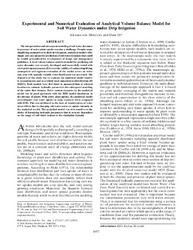| dc.contributor.author | Mmolawa, Khumoetsile | |
| dc.contributor.author | Dani, Or* | |
| dc.date.accessioned | 2019-03-13T12:31:51Z | |
| dc.date.accessioned | 2021-03-15T09:22:50Z | |
| dc.date.available | 2019-03-13T12:31:51Z | |
| dc.date.available | 2021-03-15T09:22:50Z | |
| dc.date.issued | 2003 | |
| dc.identifier.citation | Mmolawa, K., & Or, D. (2003). Experimental and numerical evaluation of analytical volume balance model for soil water dynamics under drip irrigation. Soil Science Society of America Journal, 67(6), 1657-1671. | en_US |
| dc.identifier.issn | 1435-0661 | |
| dc.identifier.uri | https://dl.sciencesocieties.org/publications/sssaj/abstracts/67/6/1657 | |
| dc.identifier.uri | http://moodle.buan.ac.bw:80/handle/123456789/134 | |
| dc.description.abstract | The interpretation and subsequent modeling of soil water dynamics in presence of active plant uptake remains a challenge. Despite many simplifying assumptions in their development, analytical models offer simple and easy means for prediction of soil water dynamics that could be readily generalized for development of design and management guidelines. A local volume balance analytical model for predicting soil water dynamics was recently developed and successfully tested with a few point measurements. However the validity of various simplifying assumptions and rigorous evaluation of the model across an entire root zone with spatially variable water distribution was not tested. The objective of this study was to evaluate the analytical model relative to measurements and to a widely used numerical model (Hydrus-2D [H2D]). Both models were first fitted to measured data at selected locations to estimate hydraulic parameters for subsequent modeling of the entire flow domain. Water content dynamics by the analytical model was in good agreement with the H2D model simulations in the absence of plants. With active plant uptake, the analytical model overestimates root water uptake at some locations when compared with H2D. This was attributed to the lack of consideration of water stress effects due to changing soil-water status on uptake intensity in the analytical model. The analytical model was also sensitive to the choice of linearizing hydraulic parameters that in turn are dependent on the range of soil water content in the simulation domain. | en_US |
| dc.language.iso | en | en_US |
| dc.publisher | Soil Science Society of America | en_US |
| dc.subject | Numerical evaluation | en_US |
| dc.subject | Analytical volume balance model | en_US |
| dc.subject | Soil water dynamics | en_US |
| dc.subject | Drip irrigation | en_US |
| dc.title | Experimental and numerical evaluation of analytical volume balance model for soil water dynamics under drip irrigation | en_US |
| dc.type | Article | en_US |

